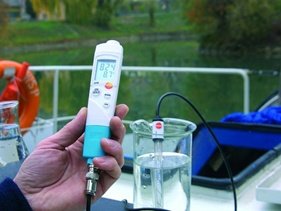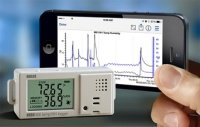10 Handy Tips For Accurate pH Measurements

Your Instrument Choice Scientists have formulated a list of 10 helpful tips to help you achieve the highest level of accuracy for your pH measurements.
1. Clean your pH electrode regularly
Even if you can't always see it, the most common cause of pH measurement inaccuracy is a dirty electrode. It not only affects accuracy, but when calibration is performed using a dirty electrode, it's as good as a house built on faulty foundations. The meter will assume the electrode is clean and then create a standardisation curve based on the calibrated readings. The incorrect calibration reference will remain valid until the next calibration – even if the meter is cleaned in the meantime. The bottomline – you readings will be inaccurate.
How to clean a pH electrode? Deposits and build-up are removed from pH electrodes using a cleaning pH cleaning solution. Watch a scientist demonstrate “How To Clean A pH Meter Using Electrode Cleaning Solution”.
2. Keep the electrode hydrated
If your pH electrode dries out, pH measurement values will begin to drift and become inaccurate. Dry pH bulbs also result in significantly slower response times.
How to fix a dry pH electrode? Submerge your pH electrode in electrode storage solution for one hour, calibrate, then it’s good to go for pH measurements.
3. Calibrate
Almost all pH meters require regular calibration. The calibration frequency and method will depend on the device you use, how precise your readings need to be, and how often your meter is used. First, refer to the instructions supplied with your pH meter tester, or contact us if you’re not sure what calibration frequency is the right one for you.
How to calibrate a pH electrode? Our scientists always recommend you calibrate your pH meter to a minimum of two points, shouldering your expected pH range - however, more points of calibration means greater accuracy.
Hint: The most common buffer solutions used for pH calibration are pH 4.01, 7.00 and 10.00.
4. Store your electrode in the proper storage solution
Do not store your pH electrode deionised water. If you do, ions will leach out from your electrode via the glass membrane - and your measurement taking will become painfully slow!
How should you store a pH electrode? Always keep your pH electrode in electrode storage solution when not in use. In circumstances where this is not possible, store in pH4 calibration solution.
5. Handle your electrode properly
When cleaning or using your meter, wiping the electrode with cloth or tissue can create static which will interfere with your pH readings.
How to handle your pH electrode properly? Never wipe an electrode. Instead, clean your electrode between measurements by rinsing and gently shaking off the excess moisture. If necessary, you can blot the probe dry with a lint-free cloth to remove excess moisture.
6. Choose the correct electrode for your application
The most common pH electrode variety is the glass bulb electrode because of its versatility and affordability. However, several tasks need a specialised electrode design. Here are some examples:
- Semi-solid products and substances (E.g. Food)
- Soils
- Solutions with a high amount of debris that can clog your electrode (E.g. Wine)
- Where substances are not complete liquids (e.g., fabrics or skin)
- Chemicals; and
- Where glass use is prohibited or must be kept to a minimum (e.g. food processing).
How to choose the correct pH electrode for your application? If you are dealing with any of the specific-use electrode applications listed above, or if you are unsure of your electrode requirements - contact us, to save you valuable time and avoid errors!
|
IC TIP: pH electrodes are consumables and, depending on use, should last between 6-24 months. When choosing a pH meter, look for pH meters with replaceable electrodes. Replacement electrodes are a fraction of a new meter’s price! |
7. Inspect and test your electrode often
There are two reasons to inspect your pH electrode often;
- Over time, the sensing portion of the glass will become insensitive and eventually fail. This is normal for a consumable item like an electrode. Expect to replace your pH meter’s electrode every 6-24 months.
- pH electrodes are usually made from glass or have glass components that make them susceptible to accidental damage. Damage to the electrode will result in erroneous readings.
How to inspect and test your electrode? Check for cracks, chips, discolouration of your electrode often. If your meter has the function, perform slope and offset calculation.
8. Adequately submerge the electrode
For accurate pH measurements, both the sensing glass and the junction need to be submerged in your sample solution, so make sure there is enough sample volume for taking accurate pH measurements.
How to adequately submerge an electrode for a pH measurement? Consult individual user guides for minimum and maximum submersion depths. Check you always have enough sample volume before taking a pH measurement.
9. Open the fill hole cap* (*only applicable to refillable electrodes)
Closed fill hole caps can lead to slower stabilisation times during measurement and calibration.
How to promote efficient stabilisation with pH electrodes with a fill cap? Loosening or removing the fill cap during calibration or measurement creates a positive pressure environment within the reference cell. Positive pressure environments promote higher flow rates of electrolyte through the junction resulting in a faster stabilisation time.
10 Keep the electrolyte solution full (*only applicable to refillable electrodes)
During everyday use and over time, electrolytes flow out from the reference junction. When electrolyte levels start to become low, readings will become unsteady and take a long time to stabilise.
How to ensure your reference electrolyte level is sufficient? Consult your user manual for specifics on how to refill the reference electrolyte. Generally, electrolyte solution should be no less than 1cm from the fill hole.
Conclusion
Following the 10 handy tips listed above for fast, accurate and precise measurements using your pH meter.
For more information or help with your pH meter, speak with an Instrument Choice Scientist. Call 1300 737 871 or email [email protected].

Also interesting
If you are interested in your local weather patterns, if you rely on your weather records or need accurate hyperlocal forecasts - then a Smart Home Weather Stations is the perfect accessory for your home.
Discover what makes a weather station Smart, how you could benefit and what you can get for under $500 here.

Onset’s award-winning HOBO data loggers are popular worldwide for a diverse range of monitoring applications. This article spotlights the HOBO MX range of data loggers that feature an innovative method to access your data remotely.
Check out the cutting-edge HOBO MX series of data logger here

